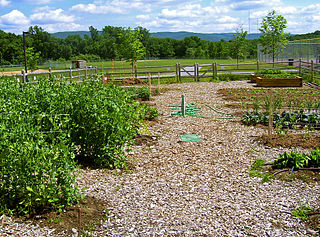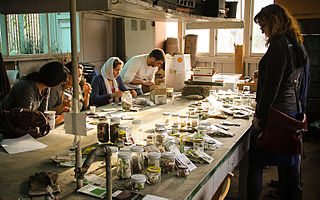Related Research Articles

Permaculture is an approach to land management and settlement design that adopts arrangements observed in flourishing natural ecosystems. It includes a set of design principles derived using whole-systems thinking. It applies these principles in fields such as regenerative agriculture, town planning, rewilding, and community resilience. The term was coined in 1978 by Bill Mollison and David Holmgren, who formulated the concept in opposition to modern industrialized methods, instead adopting a more traditional or "natural" approach to agriculture.

Forest gardening is a low-maintenance, sustainable, plant-based food production and agroforestry system based on woodland ecosystems, incorporating fruit and nut trees, shrubs, herbs, vines and perennial vegetables which have yields directly useful to humans. Making use of companion planting, these can be intermixed to grow in a succession of layers to build a woodland habitat. Forest gardening is a prehistoric method of securing food in tropical areas. In the 1980s, Robert Hart coined the term "forest gardening" after adapting the principles and applying them to temperate climates.
No-dig gardening is a non-cultivation method used by some organic gardeners.

Robert Adrian de Jauralde Hart was an English pioneer of forest gardening in temperate zones. He created a model forest garden from a 0.12 acre (500 m²) orchard on his farm. He credits the inspiration for his work to an article by James Sholto Douglas, which was in turn inspired by the work of Toyohiko Kagawa.

The following outline is provided as an overview of and topical guide to organic gardening and farming:

CERES Community Environment Park is a 4.5-hectare (11-acre) not-for-profit environmental education centre and social enterprise hub located in urban Brunswick East, Victoria, Australia.

An heirloom plant, heirloom variety, heritage fruit, or heirloom vegetable is an old cultivar of a plant used for food that is grown and maintained by gardeners and farmers, particularly in isolated communities of the Western world. These were commonly grown during earlier periods in human history, but are not used in modern large-scale agriculture.

Cornus sanguinea, the common dogwood or bloody dogwood, is a species of dogwood native to most of Europe and western Asia, from England and central Scotland east to the Caspian Sea. It is widely grown as an ornamental plant.
Garden Organic, formerly known as the Henry Doubleday Research Association (HDRA), is a UK organic growing charity dedicated to researching and promoting organic gardening, farming and food. The charity maintains the Heritage Seed Library to preserve vegetable seeds from heritage cultivars and make them available to growers.
This is an alphabetical index of articles related to gardening.
Plants For A Future (PFAF) is an online not for profit resource for those interested in edible and useful plants, with a focus on temperate regions. Named after the phrase "plans for a future" as wordplay, the organization's emphasis is on perennial plants.
Seed Savers Exchange, or SSE, is a non-profit organization based near Decorah, Iowa, that preserves heirloom plant varieties through regeneration, distribution and seed exchange. It is one of the largest nongovernmental seedbanks in the United States. The mission of SSE is to preserve the world’s diverse but endangered garden heritage for future generations by building a network of people committed to collecting, conserving, and sharing heirloom seeds and plants, and educating people about the value of genetic and cultural diversity. Since 1975, Seed Savers has produced an annual yearbook of members’ seed offerings, as well as multiple editions of The Garden Seed Inventory, and The Fruit, Nut and Berry Inventory. SSE also publishes Seed to Seed: Seed Saving and Growing Techniques for Vegetable Gardeners. The nonprofit has sold seeds to about 600 retail stores in the United States and Canada.

Acacia floribunda is a perennial evergreen shrub or tree. It is a species of wattle native to New South Wales, Queensland and Victoria, but is cultivated extensively, and has naturalised in South Australia, Tasmania and Western Australia, and also in Indonesia, Mauritius and northern New Zealand. Common names for it include gossamer wattle, weeping acacia and white sallow wattle. It grows up to 6m in height, but there is a commercial form available which only grows to about 1m tall. Its cream-colored flowers occur in the early Spring.

Pittosporum eugenioides, common names lemonwood or tarata, is a species of New Zealand native evergreen tree. Growing to 12 m (39 ft) tall by 5 m (16 ft) broad, it is conical when young but more rounded in shape when mature. Its leaves are mottled yellow-green with curly edges and a salient bright midrib, and have a strong lemony smell when crushed. It has highly fragrant clusters of attractive yellow-cream flowers in spring, followed by distinctive black seed capsules. It is found throughout New Zealand's North and South Islands along forest margins and stream banks from sea level to 600 m (1,969 ft). It is New Zealand's largest Pittosporum.

Seed swaps are events where gardeners meet to exchange seeds. Swapping can be arranged online or by mail, especially when participants are spread out geographically. Swap meet events, where growers meet and exchange their excess seeds in person, are also growing in popularity. In part this is due to increased interest in organic gardening and heritage or heirloom plant varietals. This reflects gardeners' interest in "unusual or particular varieties of flowers and vegetables", according to Kathy Jentz of Washington Gardener Magazine (Maryland).

Natural farming, also referred to as "the Fukuoka Method", "the natural way of farming", or "do-nothing farming", is an ecological farming approach established by Masanobu Fukuoka (1913–2008). Fukuoka, a Japanese farmer and philosopher, introduced the term in his 1975 book The One-Straw Revolution. The title refers not to lack of effort, but to the avoidance of manufactured inputs and equipment. Natural farming is related to fertility farming, organic farming, sustainable agriculture, agroecology, agroforestry, ecoagriculture and permaculture, but should be distinguished from biodynamic agriculture.

A seed library is an institution that lends or shares seed. It is distinguished from a seedbank in that the main purpose is not to store or hold germplasm or seeds against possible destruction, but to disseminate them to the public which preserves the shared plant varieties through propagation and further sharing of seed.

Hügelkultur, literally mound bed or mound culture, is a horticultural technique where a mound constructed from decaying wood debris and other compostable biomass plant materials is later planted as a raised bed. Considered a permaculture practice, advocates claim that the technique helps to improve soil fertility, water retention, and soil warming, thus benefitting plants grown on or near such mounds.

Regenerative agriculture is a conservation and rehabilitation approach to food and farming systems. It focuses on topsoil regeneration, increasing biodiversity, improving the water cycle, enhancing ecosystem services, supporting biosequestration, increasing resilience to climate change, and strengthening the health and vitality of farm soil.

A community orchard is a collection of fruit trees shared by communities and growing in publicly accessible areas such as public greenspaces, parks, schools, churchyards, allotments or, in the US, abandoned lots. Such orchards are a shared resource and not managed for personal or business profit. Income may be generated to sustain the orchard as a charity, community interest company, or other non-profit structure. What they have in common is that they are cared for by a community of people.
References
- 1 2 3 4 "The constant gardener". New Zealand Geographic. Retrieved 2023-04-25.
- ↑ Sharpe, Marty (2022-04-29). "Debt, distrust and deadlock: How peace at an idyllic eco-village was shattered". Stuff. Retrieved 2023-05-10.
- ↑ Vine, Gillian (2014-05-10). "Heritage plant project backers sought". Otago Daily Times Online News. Retrieved 2023-05-10.
- 1 2 3 4 "A couple's decades-long mission to save New Zealand's heritage seeds and fruit trees at the Koanga Institute". thisNZlife. 2020-05-26. Retrieved 2023-05-10.
- ↑ "Regeneration". New Zealand Geographic. Retrieved 2023-05-10.
- ↑ "Sowing seeds of hope: Kay Baxter, Koanga Institute". RNZ. 2020-02-11. Retrieved 2023-05-11.